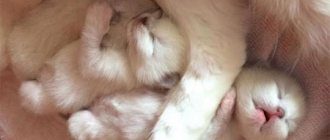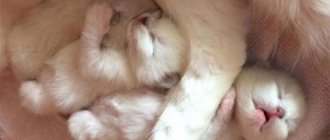The cat usually does not require special care throughout pregnancy. Most cats remain this way when it comes time to give birth to their kittens. The birth occurs without any human intervention, with normal human participation limited to standing aside and giving the mother space.
However, this is not always the case. If your cat is past her due date or you think her health may be in danger, it may be time to induce labor.
When you need help
Is it possible to induce labor in a cat on your own? In some cases, it is not only possible, but also necessary. As a rule, pregnancy in cats lasts 55-60 days. A slight delay in the birth of kittens is normal, but if the animal does not give birth 68-70 days after mating, measures must be taken. The babies grow in the mother's womb, becoming larger and larger, and the larger the kittens, the more complications the birth will be.
© shutterstock
Signs of approaching labor
The duration of a cat's pregnancy is approximately 60 days, give or take five days. If you're not sure how far along your cat is, look for telltale signs that birth is imminent.
- Nesting : A day or two before giving birth, your cat will look for a quiet and safe place to give birth to her kittens. She can choose the place you allocate for her, or hide in the back of a closet or under the bed.
- Changes in behavior : You may notice that your cat begins to pace restlessly, pant, overgroom (especially in the genital area), and sing excessively. She will also stop eating.
- Physical changes during labor : Your cat's rectal temperature may drop to around 37℃ and she may vomit. You may see the belly "drop" in the days before giving birth, and your cat's nipples may become larger, darker, or pinker.
- Signs of active labor : Contractions—the movements of the uterus that move the kitten through the birth canal—may cause your cat to howl in pain. You may also see blood or other fluids discharge.
© shutterstock
Medicines
You can induce labor in a cat at home using certain medical products.:
- Oxytocin . It causes contractions of the uterus and helps speed up the labor process. This synthesized hormone can only be used after consultation with a veterinarian.
- Travmatin . Relieves pain and helps regulate contractions, helps avoid complications and injuries while the animal is giving birth, promotes healing and prevents inflammation.
- Gamavit . Stimulates the uterine muscles, facilitates childbirth in difficult cases.
- Calcium gluconate . Not only stimulates labor, but also helps milk production.
In order not to harm your cat, you should carefully read the instructions for the medications and be sure to consult a veterinarian.
What research must be carried out?
Let us repeat once again - the decision on the advisability of artificial childbirth should be made only by a veterinarian. To accurately determine the need for the procedure, a specialist must conduct a number of diagnostic studies:
- An ultrasound of the entire abdominal cavity is required. This method allows you to find out what condition the animal’s uterus is in, how many formed fetuses are in it, whether there is a malpresentation, or whether a dead kitten is lying across the birth canal.
- It is not recommended, but if it is not possible to do an ultrasound, radiography can be used for the same purposes.
- Blood tests are taken. The veterinarian will be especially interested in the level of hormones, since this sign indirectly indicates the animal’s ability to give birth on its own.
- A visual examination of the external genitalia is also indicated. This can be useful if you suspect infectious diseases that can also slow down the birth process.
Why is all this being done? It’s simple - before inducing labor, the specialist must make sure that the cat’s body can withstand it.
Here is a classic example: a cat that could not give birth (there were no uterine contractions) was injected with a “horse” dose of oxytocin. As a result, there is a need for urgent abdominal surgery. And all because the animal had an incorrect presentation of the kitten, and as a result of powerful contractions of the uterine myometrium, the organ simply tore. The same can happen when the placental membranes fusion with the uterus, if there are benign or malignant tumors in its cavity, etc. Not to mention the cases when the owners incorrectly determined the gestational age, as a result of which the stimulation of labor led to miscarriages.
We repeat once again - “anyhow” using drugs intended to induce labor is strictly prohibited!
Such amateur activities will not lead to anything good. Most likely, the cat itself and all its offspring will die.
How to act
If there is a need to induce contractions in a cat, you need to use Oxytocin. This drug will help strengthen the tone of the muscle tissue of the uterus before labor begins. The medicine is administered intramuscularly or subcutaneously; its effect begins within 2-3 minutes after the injection. It is very important to follow the dosage, otherwise complications may arise, including the death of the kittens.
How much drug should I use? For cats, the following dosage should be used: 0.2-0.3 ml for intramuscular or subcutaneous injection, the injection is given between two contractions. If there is no result within 1/3 hour, the drug is re-administered at the same dose. The maximum number of injections is 3; if there is no effect, you cannot increase the dosage - this will lead to negative consequences.
How to give an injection? To help your pet give birth to offspring, you should inject the drug into the withers. To do this, the animal’s skin is grabbed with one hand and an injection is made into the hollow formed at the back. It is important to puncture the skin and inject the drug between the skin and muscles.
© shutterstock
The intramuscular injection is easy. The optimal place for the injection is the thigh, the paw is held with one hand, and the syringe needle is inserted at an angle with the other hand. After the procedure, the injection site should be gently massaged, this will help the drug dissolve faster. Similar injections are given if the cat carries the pregnancy to term.
It is extremely important to wash your hands thoroughly before injection and use only sterile instruments. The same needle cannot be used twice.
Normal and abnormal course of labor
Prevention of all possible complications during childbirth begins with caring for a pregnant cat . As soon as you discover that your pet is pregnant, regardless of whether mating was planned, she must be shown to a veterinarian.
A cat's pregnancy can be determined from 2–3 weeks using a blood test. At 3–4 weeks, the expectant mother's mammary glands swell. As the gestation period increases, the following signs are observed:
- Increased hunger.
- Redness of the nipples.
- Toxicosis.
- Slight but constant weight gain.
- Behavioral changes - frequent meowing, restlessness, unusual affection or irritability.
During the normal course of pregnancy, by about 5–6 weeks, the pet’s belly becomes noticeably rounded. If gestation proceeds without complications, the cat receives decent care, has no genetic defects, and birth occurs from 64 to 71 days of pregnancy.
Important! During the normal course of pregnancy, before the onset of contractions, the cat should not experience any discharge from the genitals. The only exception is early rejection of the mucus plug, which can occur several weeks before birth.
It will be easier for an inexperienced owner to cope with the situation if the nest for birth is prepared in advance. It is necessary to monitor the cat’s behavior; most often, she herself chooses a suitable (from her point of view) place. You can take the initiative and equip a nest for your cat from a spacious box. In order for the expectant mother to feel safe, the box must be closed (have a roof).
During the first contractions, you may find that the cat is restless, constantly entering the nest, or looking for a suitable place to give birth to kittens. The pet can meow loudly and attract the attention of the owner, especially if she is about to give birth for the first time. The first contractions bring discomfort, but the cat successfully hides the pain. The owner may not notice the discharge of amniotic fluid and the rejection of the mucous plug, since the cat licks the genital area.
As the labor process progresses, contractions will intensify and the interval between them will decrease. When the interval is reduced to 20–30 seconds, the cat will lie down on its side and prepare to push.
The first kitten takes longer to be born than all the others; to expel it, the cat will need to make 3-4 strong attempts. The total duration of the process from the start of contractions to the appearance of the first kitten can take from 2 to 24 hours. Normally, contractions last up to 12 hours, and pushing at the birth of the first kitten lasts up to 1 hour.
Note! After the birth of the first kitten, the remaining babies should appear at intervals of 10–20 minutes.
As soon as the baby is born, the cat licks its face, gnaws the umbilical cord and eats the afterbirth. If the woman in labor does not pay attention to the kitten, and the expulsion occurs too quickly, the pet may be in rapid labor. This complication is associated with severe pain, so it is advisable to immediately remove the kittens from the nest, remove fluid from the respiratory tract, rub them and place them on a heating pad.
Gamavit for obstetrics
This traditional medicine is recommended to be used to help cats during childbirth for several reasons.:
- It helps to avoid uterine rupture due to excessively large offspring;
- It prevents diseases such as endometritis and pyometra.
- Reduces the risk of birth and postpartum complications.
- Allows the animal to quickly return to normal after birth.
The product is used by injection - intravenous, subcutaneous and intramuscular. To speed up the absorption of the medicine into the blood and induce labor, the injection should be given under the shoulder blade. In agreement with the veterinarian, the drug can be given to the cat to drink. For an adult cat, the dosage of the drug for one injection can be from 1 to 1.5 ml.
© shutterstock
When is it appropriate to induce labor and when to perform a cesarean section?
When do you really need to speed up labor? As a rule, in cases where the animal has atony (complete absence) or hypotension (weak contractions) of the uterus. But it should be remembered that the rigidity of the uterine wall should be normal. In other words, in cases where the animal is already exhausted and weakened by long, protracted labor, it is not recommended to resort to stimulating uterine contractions. As in the situation already described above, such “help” can lead to rupture of the walls of the organ.
In addition, in no case should they “force” the birth process if there is even the slightest suspicion of malpresentation or congenital deformities of the fetus. Intensified contractions of the uterine wall in these cases can lead to severe injuries, rupture of the walls of the organ and, subsequently, the death of the animal from internal bleeding.
In case of prolonged labor, kittens blocking the birth canal due to malpresentation, deformities and large fetuses, it is strongly recommended to immediately use a cesarean section.
What to do in cases where the death of cubs is suspected? Most likely, a caesarean section is also preferable. This is due to the need to clean the entire uterine cavity, remove putrefactive secretions and other decay products from there, and, possibly, further remove the organ itself (as well as the ovaries).
Be prepared for leaks!
Even after the cessation of lactation or in its last stages, unexpected copious discharge of milk from the breast is possible. This can happen when hugging a partner, when having sex with him, when being sexually aroused, when thinking about a child, when touching the breast. To prevent unexpected milk leaks, wear absorbent pads in your bra. Keep a spare supply of such gaskets with you. Wear dark-colored tops so that milk stains are not as noticeable. Take a spare set of clothes with you, especially for more important occasions.
Express some milk before leaving the house. If you feel milk leaking, cross your arms over your chest to stop the flow.
In all cases, get advice from a breastfeeding specialist on how best to stop lactation in your case.
Preparation
Preliminary measures will not be superfluous, although most breeds cope well with pregnancy on their own. So what should you do if your cat gives birth for the first time?
First, we set up a nest. A regular cardboard box is perfect for this. We put a diaper or any other fabric on the bottom for convenience. Experienced owners recommend using several layers of soft paper or baby diapers. Special houses for cats are suitable for nesting. The main thing is that the expectant mother has free access.
Secondly, the cat should build a nest in a warm, ventilated room. We exclude drafts and the presence of other animals. We exclude the toilet and bathroom. The ideal option would be a small room where the cat will not be disturbed. For example, a storage room.
Thirdly, in order for the pet to successfully give birth, it is provided with food and clean drinking water. All this is placed near the nest or place where the cat prefers to sleep. Presumably she will give birth there.
What items will be needed to help the cat, stimulate and speed up the process? The list may change, but if the owner has most of the above, then half the battle is already done:
- Disposable diapers and wet wipes.
- Scissors.
- Disposable syringes and a number of medications to eliminate complications.
- Vaseline oil to stimulate the vaginal muscles.
- Surgical (or silk) thread to tie the umbilical cord.
- Iodine, brilliant green, disinfectants.
How to care for a cat after giving birth
Immediately after the birth is completed, all afterbirths are eliminated, the animal’s body is exhausted. Therefore, we need to help him during this period:
- Provide clean water at all times to prevent dehydration.
- Feed soft, easily digestible food to normalize the digestion process, especially for cats after cesarean section.
- Keep your pet in clean conditions, change the bedding daily. Monitor the presence or absence of discharge - it can be profuse, mixed with pus if there are complications.
- Ensure peace and do not disturb the cat.
- Contact the veterinarian 1-2 times for a general examination and undergo laboratory tests as necessary.
Attention! If the cat is weak, a tray and feeder are placed next to its bedding so that it does not have to move around the room.
What to do if the kitten is born too big
If you have a large fetus, it is recommended to choose one of the following methods for delivery;
- removing the kitten using forceps;
- C-section.
The first method can lead to unwanted complications for the kitten. For example, a leg may break because the muscle and bone tissue is not yet sufficiently developed. Therefore, doctors more often recommend surgery.
Cat with newborn kittens
When to urgently contact a veterinarian
After giving birth, the cat should gradually recover. She gains strength, she begins to move around and feed her offspring.
But there are cases when the animal becomes lethargic for a long time, and discharge forms in the genitals. The pet refuses to eat. This is a reason to contact a veterinarian. The cat's body temperature may rise greatly and convulsions may begin. All this can lead to her death if timely treatment is not started.
Childbirth is a natural process for cats, but in some cases it is complicated. Therefore, the owner needs to know what to do during this period. This applies to any pet, be it a purebred British cat or an ordinary yard cat. Complications may occur during the first or each subsequent birth.
Even the cat helps the cat give birth!
Who would have thought that even a cat helps a cat give birth! Vietnamese resident Thuy Duong Panda has a cat named Yello and a cat named Tam Do. When Tam Do gave birth, her partner did not leave her side and provided all possible assistance, supporting and reassuring her.
The couple gave birth to four healthy kittens, and this was Tam Do's first birth. The kittens' father supports his beloved even after giving birth.
Take care of your pets, do not be afraid to help. You will not harm the kittens, but you will help the cat and her cubs cope with difficulties. Moreover, if necessary, you can always call a veterinarian who will tell you what to do in this or that case.
Advantages of calling Virilis Group specialists to your home
- Travel to any area of the city and region without restrictions.
- No insurance, registration or citizenship is required to receive medical care.
- Providing assistance to children of any age.
- Experience in responsible treatment of children in St. Petersburg since 1991.
- 6 own children's medical centers with 650 specialists in 49 specialties.
- Possibility of diagnostics and continuation of treatment in our clinics.
- Coordination with other doctors of the VIRILIS Group of Companies clinics: we are a single team, and not individual doctors from a “mobile” clinic.
- 24/7 contact center.
- Issuance of official medical certificates and documents.
- Possibility of purchasing a package of a comprehensive medical program for a child, including the “Emergency Care” and “Comprehensive Examination at Home” packages.
- Special medical programs for newborns and infants.
Helping a newborn kitten
When the fetus is born, it is surrounded by a bubble of amniotic fluid. If the cat does not lick the kitten on its own, you need help getting out of the bubble. Since the kitten has been in liquid for a long time, its mouth contains liquid. It needs to be sucked out using a pipette or a small enema.
If a cat gives birth to a kitten butt first, damage to the kitten's limbs may occur. In this case, you cannot do without the help of a veterinarian. You cannot try to fix the limbs on your own; giving medications is not recommended.
Important! After removing the kitten from the amniotic sac, it is given to the mother for licking and feeding. This is where a person’s actions end.
Kitten after being removed from the bubble
What to do at home?
How to induce labor at home?
To help a giving birth cat and speed up the birth process, it is recommended to use the drug Oxytocin. It is an artificial hormone that makes the uterus contract faster. However, this medication is not safe, so the first thing you need to do before using it is to contact the veterinarian who saw the pregnant cat. Improper use of the medicine may cause severe bleeding or cervical rupture.
The drug Travmatin will help speed up and relieve the pain.
You can also use another pharmaceutical product called “Travmatin”. If the owner sees that the cat is in pain, this medicine is perfect. It has an analgesic effect and allows you to regulate contractions. In addition, in veterinary practice the medication is used to prevent complications.
A pharmaceutical product called “Gamavit” will also help. In veterinary medicine, it is used to stimulate the muscles of the uterus. Often used in difficult situations to make the birth process easier and faster. It is also recommended to resort to calcium gluconate, which smoothly enhances labor and also provokes increased production of breast milk. This medication can also be used after the birth of offspring, as it effectively fights eclampsia. This pathology develops after childbirth and is a nervous disorder. Often the disease is caused by a lack of calcium in the body of the cat who gave birth.
The lack of this element not only affects the condition of teeth, bones and coat. It can also provoke seizures and lead to the death of your pet.
ethnoscience
For a homemade stimulating cocktail you will need an ascorbic acid preparation.
To induce labor, the owner will first need to put the pet in a position as if she is defecating, and then begin to massage the peritoneum. Next, it is recommended to prepare a cocktail that can be used instead of Oxytocin. You will need to fill the syringe with 2 ml of ascorbic acid, 4 ml of calcium gluconate and glucose. To force a cat to give birth, the injection must be given intramuscularly, but only before the first baby appears. The dosage is calculated as follows: 2 ml of the product per 10 kilograms of the pet’s body weight.
The cat can't give birth
When the animal strains, but this does not help, veterinarians recommend resorting to the medications described above. If, with the help of medications, the pet is unable to give birth, it is important for the owner to call a veterinarian as soon as possible or take the cat to the clinic. This is an important condition, since sometimes the pet requires resuscitation, otherwise it may die.
Kitten stuck
To carry out this manipulation, you should use Vaseline.
If the baby's head has already appeared, but the cat is unable to push it out, the owner will need to arm himself with Vaseline and sterile gloves. When a kitten is stuck in the birth canal, you need to carefully lubricate the vagina, then insert your finger into it and find the elbow folds of the cat's paws. The owner should grab both limbs and gently turn the baby from side to side, trying to move the paws forward.
Situations are not excluded when the afterbirth does not come out. In this case, you will also need to take sterile gloves, after which you need to insert your finger into the vagina, try to feel the afterbirth and remove it. If you can’t cope on your own, a veterinarian’s intervention is required. When a bubble has emerged, which often breaks inside the female, it should be broken independently, but your hands should first be disinfected.
A kitten is born dead
The baby will begin to breathe again after the passages are cleared of accumulated fluid.
If the owner discovers such a situation, it is important not to panic. Babies may only appear dead, which is often observed when the airways are blocked. To revive the cat, you need to use a pipette to clear the pathways, and then stimulate breathing by holding it by the limbs and holding it upside down. Next, the baby should be placed on the cat's chest. However, there are situations when kittens are actually born dead. If the cat has already given birth to 2-3 dead babies, and when you feel her peritoneum you can find another fetus, you need to visit a veterinarian. Sometimes a caesarean section is required.











